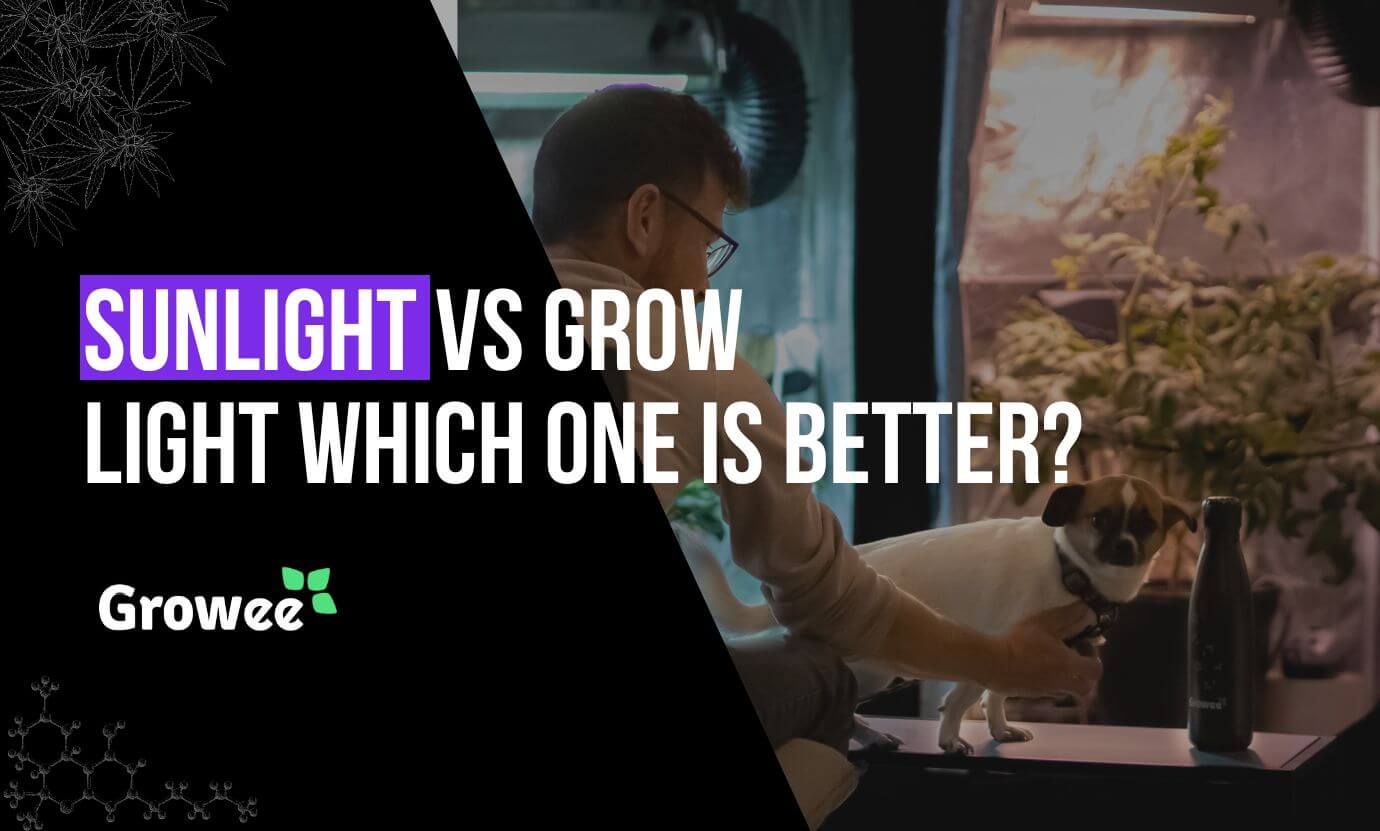If you are just starting the journey into hydroponics, then one of the things you must familiarize yourself with is lighting. The simple fact is that all plants, whether hydroponically grown or otherwise, require light to grow, real light of the proper spectrum.
Unfortunately, a regular lightbulb like the one in your side lamp won’t be enough to produce fast, healthy, and strong plant growth. In nature, plants get real sunlight.
However, if you are growing hydroponically, it means that you’re probably growing inside, which means that your plants won’t be exposed to real sunlight. So, can you use grow lights for hydroponics? Let’s figure out everything there is to know about grow light vs sunlight for hydroponics.
What is Hydroponics?
Before we start talking about grow lights vs sunlight for hydroponics, let’s quickly discover what exactly hydroponics is. So, hydroponics is the process of growing any kind of plant, whether tomato, cannabis, or anything in between, using water as the main medium.
Unlike traditional growing methods that involve the use of soil, like traditional crop farming, hydroponics has the plants suspended in an inert medium that does not provide the plant with any nutrients, such as peat, coco coir, or clay pellets.
Instead of getting nutrients from the medium, in a hydroponics system, the plants get their nutrients from a nutrient-rich watering solution. The roots of the plants hang down into some sort of chamber or channel where they are exposed to this nutrient solution, thus allowing them to grow big and strong.
Why do Hydroponics Plants Need Light?
One of the most important components of plant growth, whether in hydroponics or not, is light. The bottom line is that all plants need light to grow. Without light, plants cannot engage in what is known as photosynthesis.
Photosynthesis is the process of using the energy provided by light to take carbon dioxide and water, and turn it into glucose and oxygen, both of which are required for plant growth. Plants need glucose to grow. It’s their fuel. Without light, plants can’t create glucose, and therefore won’t grow, or realistically, will die.
See How Growee Can Save You Time By Automating Your Plants Feeding
Water pH – Automated pH Up and Down Control
Nutrients Mixing – Automated Nutrient Dosing with Target EC / PPM Control.
Control From Anywhere – WiFi Connection and mobile App
Effects of Sunlight on Plants
Okay, so one of the major effects that sunlight has on plants is that it allows them to perform photosynthesis. As discussed above, plants need to be able to perform photosynthesis, or else they cannot convert carbon dioxide and nutrients into glucose to grow. Photosynthesis is the main effect.
However, there is a bit more that goes on here. The light is absorbed by the chlorophyll, generally blue and red lights, which then leads to the chemical reactions of photosynthesis, and ultimately to plant growth.
The amount of light that plants get also dictates their growth stage. For instance, when plants get plenty of light, such as in the spring or early summer, they usually vegetate, which means that they grow foliage.
When the days shorten and the light becomes less frequent and intense on a daily basis, it signals plants to start flowering, which biologically speaking, is how plants reproduce.
At home, if you are growing plants, changing the lighting schedule could induce flowering to happen, something that every cannabis grower needs to be familiar with.
Interestingly enough, sunlight is also needed for chlorophyll production, energy distribution, and more!
How Can Light Cycles Prevent Flowering in Cannabis Mother Plants?
Cannabis mother plants are typically kept in a vegetative state to provide a continuous source of healthy cuttings (clones) for propagation. To prevent these mother plants from transitioning to the flowering stage, growers maintain a consistent 18 hours of light and 6 hours of darkness (18/6) or even longer photoperiod.
By providing this extended light cycle, cannabis mother plants receive the signal to stay in the vegetative growth phase and continue producing new growth. Growers can achieve this with regular fluorescent or LED grow lights, and it’s essential to ensure that there are no interruptions in the light cycle during the dark period.
Maintaining mother plants in a vegetative state allows growers to take cuttings from them, root these cuttings, and then grow them into healthy and genetically identical new cannabis plants. This cloning process is a common practice in cannabis cultivation for preserving desired genetic traits and ensuring a consistent crop.
At home, if you are growing plants, changing the lighting schedule could induce flowering to happen, something that every cannabis grower needs to be familiar with.
Interestingly enough, sunlight is also needed for chlorophyll production, energy distribution, and more!
Why Autoflowering Cannabis Ignores Light Cycles
Autoflowering cannabis strains are unique because they do not rely on light cycles (photoperiods) to trigger their flowering stage. Instead, they automatically transition from vegetative growth to flowering based on their age, typically after a few weeks. This characteristic is due to the presence of Ruderalis genetics in their lineage.
Unlike photoperiodic cannabis strains, which require specific light cycle adjustments to induce flowering (typically 12 hours of light and 12 hours of darkness), autoflowers will start flowering regardless of the light cycle. This resilience to light changes makes them a popular choice among growers, especially for those who prefer a more straightforward cultivation process.
The ability of autoflowers to flower independently of light cycles makes them suitable for indoor and outdoor cultivation. Growers can maintain a consistent light cycle throughout the entire growth cycle or even provide 24 hours of light per day without worrying about changing the photoperiod to initiate flowering. This simplicity and flexibility in lighting requirements make autoflowering cannabis strains a convenient choice for both novice and experienced growers

What Are Grow Lights and How Are They Different?
As anybody growing plants hydroponically needs to know, grow lights are designed to stimulate fast and efficient plant growth. Grow lights are generally designed to emit different light wavelengths, or in other words, provide light across the spectrum.
In case you didn’t know, plants in their vegetative stages generally need blue light, whereas flowering plants usually need red light.
Blue light stimulates foliage growth, whereas red light stimulates fruit and flower growth. So, if both grow lights and sunlight allow for plant growth, then what’s the difference between them?
Grow Light vs Sunlight: The Better Option
Let’s take a quick look at all of the major differences between sunlight and grow lights, to determine which is the better option for you.
The Spectrum
Sunlight releases a full spectrum of light along all wavelengths, which means that it provides plants with blue, red, and other types of light, all at once. With grow lights on the other hand, you have to purchase the right kind. Not all grow lights are UV lights or full-spectrum lights.
Cheap grow lights might not emit any red or blue light at all. Therefore, when you buy a grow light, make sure to look into what kind of light it releases. It’s all about being able to exert control over the type of lights your plants get.
Light Intensity
Depending on where you are, the intensity of the sunlight can vary greatly, which can also depend on weather, time of day, and more.
However, grow lights appear to be the much better option here, because as long as they are plugged in, they produce consistent light at all times of day or night.
On that note, by buying larger and smaller, or higher or lower wattage lights, as well as by changing their position, you can also easily control the light intensity or amount of light that your plants get.
Timing
Another benefit of using grow lights has to do with timing. As mentioned above, it’s the sun’s schedule that determines when plants transition from their vegetative to their flowering stages in the wild.
If growing outdoors with sunlight, you are at the whims of the seasons. However, with a good grow light, you can alter the lighting schedule yourself, therefore allowing you to induce flowering in your plants whenever you see fit.
Required Space
Unlike grow lights that take up space, sunlight is very space efficient. However, keep in mind that this means that you would have to grow outdoors, something that is not ideal for hydroponics. Although grow lights take up some space, you just can’t grow hydroponic plants indoors without those lights.
Cost
Something that you should keep in mind is that grow lights can be expensive to buy, plus they constantly use costly energy too. Sunlight on the other hand is 100% free to use.
What Should be the Intensity of Light for Hydroponics?
Many people wonder how intense their lights need to be to grow plants hydroponically. For the record, light intensity is generally measured in Photosynthetic Photon Flux Density or PPFD, and the measure for this is μmol/m²/s, or micromoles per square meter per second.
In general, different groups of plants have varying PPFD requirements for optimal growth and development. Here are some guidelines for PPFD levels:
Herbs and Leafy Greens: Herbs and leafy greens typically thrive with a PPFD range of 150 to 250 μmol/m²/s.
Fruiting Plants: Fruiting plants, such as tomatoes and peppers, have higher light requirements and typically need a PPFD in the range of 600 to 800 μmol/m²/s to support fruit production.
Cannabis: Cannabis, a particularly light-demanding plant, benefits from high-intensity light. Research studies, such as the one conducted by [Researcher Name], have shown that cannabis plants achieve optimal growth and flowering with a PPFD level of approximately 900 μmol/m²/s.
Among growers, it’s considered a best practice to aim for a range of 250-400 watts per square meter (W/m2) when using LED grow lights. This range is in line with the general principle of providing sufficient light intensity for optimal plant growth. However, it’s important to keep in mind that recommended wattage levels can vary based on factors such as the type of plants being cultivated, their growth stage, and the specific LED technology employed. Therefore, consulting with experienced growers and considering various sources of information is advisable to determine the most suitable lighting setup for your specific cultivation goals.
What is the Best Light Position for Hydroponics?
In general, you want the lights to be above the plants to allow for good upward growth. The main point to keep in mind here is that the lights need to be a certain distance above the plants.
For instance, with LED lights, they should be between 12 and 24 inches from the plants. If the lights are too close, you may burn the plants, but if the lights are too far away, it may cause the plants to stretch out too much.
Types of Grow Lights
There are a few different types of grow lights that are quite popular for hydroponics, so let’s take a quick look at each of them.
HID Lights
HID grow lights can be divided into two types, MH or metal halide and HPS or high-pressure sodium, with the former being ideal for emitting blue light, and the latter for red light. Keep in mind however that unlike with LED lights, the light spectrum with these cannot be changed.
Although they may be more energy-efficient than fluorescent lights, they don’t come anywhere close to LED lights. These types of lights also generate a lot of heat, while not having the longest lifespans.
LED Lights
LED lights or light-emitting diodes are a fan-favorite among cannabis growers and other hydroponic farmers. They tend to be quite small and space-efficient, not to mention that they don’t produce much heat or use much energy.
At the same time, LED lights also tend to have much longer lifespans than other types of grow lights. Even better is the fact that LED lights can be customized to emit light from any spectrum, whether blue, red, or both together. When it comes to LED grow lights vs sunlight, using LED lights is your best bet!
Fluorescent Lights
Fluorescent lights produce a broad light spectrum, so they should be fine for most types of hydroponic plant growth. However, they don’t have long lifespans and they aren’t overly energy efficient either. By all means, high-quality LED grow lights are best for hydroponics.
How to Achieve the Optimal Hydroponic Garden
Let’s go over some quick tips on how to achieve the best hydroponic garden possible.
- There are many types of hydroponic systems, so do some research and choose the one that will work best for your needs.
- Make sure to choose the right kind of grow light, which in most cases will be an adjustable LED grow light that releases both red and blue light (preferably one where you can choose to have either the red or blue light on, or both at once.
- Make sure to use high-quality water with a pH level ranging from 5.5 to 6.5, and be sure to always measure the EC or electrical conductivity of your nutrient solution.
- Keep in mind that temperature, humidity, and ventilation all play crucial roles in hydroponic growth as well.
The other way to ensure optimal growth is by using something like the Growee Automated Hydroponic System, something that can help you control all of the most important hydroponic growth parameters.
Conclusion
The bottom line as far as the grow light vs sunlight debate is concerned is that if you are growing a hydroponic garden, then the only realistic solution is to use an indoor grow light.
FAQ
Why Do Hydroponic Plants Need Light?
Light is crucial for plant growth, enabling a process called photosynthesis. During photosynthesis, plants convert carbon dioxide and water into glucose and oxygen, essential for their growth. Without adequate light, plants cannot perform photosynthesis and will not thrive.
What Effects Does Sunlight Have on Plants?
Sunlight not only powers photosynthesis but also influences plant growth stages. Abundant sunlight, such as in spring and early summer, encourages vegetative growth, resulting in lush foliage. In contrast, a 12 hours of light and 12 hours of darkness (12/12) photoperiod is used during the late flowering stage of cannabis cultivation to trigger bud development and maturation.
How Can Light Cycles Prevent Flowering in Cannabis Mother Plants?
Cannabis mother plants are kept in a vegetative state to produce healthy cuttings (clones) for propagation. Growers maintain an 18 hours of light and 6 hours of darkness (18/6) or longer photoperiod to prevent them from transitioning to the flowering stage. This encourages continual growth and facilitates cloning.
Why Do Autoflowering Cannabis Strains Ignore Light Cycles?
Autoflowering cannabis strains possess genetics that allow them to automatically switch from vegetative to flowering stages based on age, typically after a few weeks. Unlike photoperiodic strains, they do not require specific light cycle adjustments, making them suitable for growers seeking a simplified cultivation process.
What Are Grow Lights and How Are They Different from Sunlight?
Grow lights are designed to facilitate fast and efficient plant growth. Unlike sunlight, they emit light across various spectrums. Plants in their vegetative stages require blue light, while flowering plants need red light. Grow lights offer precise control over light spectrum and intensity.
What Are the Types of Grow Lights?
There are several types of grow lights, including:
HID/HPS Lights: High-Intensity Discharge lights, such as high-pressure sodium (HPS), emit red light, ideal for flowering stages but less customizable than LEDs.
LED Lights: Light-emitting diode lights are energy-efficient, space-efficient, and customizable for different growth stages, making them a favorite among growers.
Fluorescent Lights: These lights provide a broad spectrum but have shorter lifespans and are less energy-efficient compared to LEDs.
What Is the Best Light Intensity for Hydroponics?
Light intensity is measured in Photosynthetic Photon Flux Density (PPFD) and varies for different plants. Guidelines include:
Herbs and Leafy Greens: 150 to 250 μmol/m²/s.
Fruiting Plants: 600 to 800 μmol/m²/s.
Cannabis: Around 900 μmol/m²/s for optimal growth and flowering.
What Are the Key Differences Between Sunlight and Grow Lights?
The Spectrum, Light Intensity, light cycle, Weather Conditions, ability to control the light parameters, required space and cost.
What Is the Growee Automated Hydroponic System?
The Growee Automated Hydroponic System is an advanced hydroponic conroller designed to simplify and optimize plant cultivation. It integrates feeding and pH automation to provide precise control over critical hydroponic growth parameters. This system streamlines the process, making it easier to achieve robust and healthy plant growth.
How Does the Growee Automated Hydroponic System Benefit Growers?
Growee empowers growers by automating key aspects of hydroponic cultivation. It enables consistent nutrient delivery and pH level maintenance, reducing the risk of human error. With the Growee system, growers can ensure optimal growth conditions for their plants, resulting in higher yields and healthier crops.



